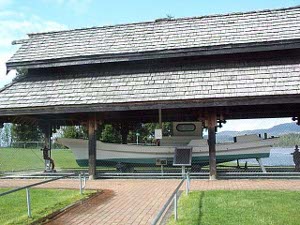 Charles Hayes, the founder
Charles Hayes, the founder
How small a town is Prince Rupert? Well, the local radio broadcasts the daily specials at each of the restaurants.
 Charles Hayes, the founder
Charles Hayes, the founder
The museum is new and filled with the attractive displays we have come to expect: First Nations artifacts, a stuffed sea otter, fishing equipment, historical memorabilia from the town. It appears to be under the wing of the North Island College, which shares quarters with the museum, art gallery and tourist information center. Curiously, none of the aboriginal items was dated, so it was unclear which were ten years or several hundred years old. We're learning to accept the fact that most of the totem poles and masks were created fifty years ago or even later, as part of the government's program to reinvigorate native culture -- in 1922 the Canadian government confiscated masks and costumes and outlawed potlaches (communal gatherings) in an attempt to Canadianise the First Nations, but starting in the sixties native artisans have been encouraged to develop carving and painting. Now many centers offer tours, official signs sometimes bear both English and Indian text, but the majority of First Nations ceremonies and dances are kept private.
The City Hall was built as a Federal building in 1938, complete with First Nations-inspired motifs. The building is still striking, amid several  The Kazu Maru
others of similar vintage on the main shopping street.
The Kazu Maru
others of similar vintage on the main shopping street.
Next to city hall stands the statue of Charles Hayes, the founder of Prince Rupert. Hayes, a consummate entrepreneur, developed the idea of the Grand Trunk Railroad. He charmed the Canadian government into paying for its construction, then charmed workers, miners, fishermen, anybody into moving into the frontier town at the end of the line. Gradually people began to suspect that Hayes' real motive was to connect this rail line with a route to Chicago through the United States, but before the Canadians could pursue their inquiries Hayes went down with the Titanic, leaving Prince Rupert, and northwest British Columbia, to continue to develop as best they could. After a lot of hemming and hawing, the Canadian government paid to complete the CN railway, which insures the city's continued existence.
 Home for Lost Soles
Home for Lost Soles
Near the water's edge a marine memorial park has recently been built. One of the major elements is a Japanese fishing boat, the Kazu Maru, in its protective building, a Shinto shrine. This boat washed up against the rocks of the Queen Charlotte islands in 1987. It turned out to be the boat of a retired civil servant from Owase, Japan who disappeared on a fishing trip in 1985. Owase is the sister city to Prince Rupert, so the city officials asked the fisherman's widow if they could keep it for their park, and she agreed -- a poignant thread between the two cities.
We haven't yet seen the sunken gardens which lie behind the Courthouse. This is supposed to be a delightful garden spot. According to the official brochure it is "the previously excavated location of the Courthouse. Change of Political Party for Provincial Government resulted in moving the building site forward".
The final landmark is one we noticed on our return from the lava beds: Prince Rupert's shoe tree, also a Home For Lost Soles, rivals that of Port Hardy. Is this the beginning of a British Columbia trend?